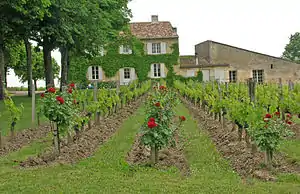Saint-Émilion AOC
Saint-Émilion is an appellation d'origine contrôlée (AOC) for wine in the Bordeaux wine region of France, where it is situated in the Libourne subregion on the right bank of the Dordogne. Saint-Émilion is registered as a World Heritage Site by UNESCO, the United Nations Educational, Scientific and Cultural Organization.


Its 5,400 hectares (13,000 acres) represent 67.5% of the total area of wine-producing communes (Saint-Émilion, Saint-Christophe-des-Bardes, Saint-Hippolyte, Saint-Étienne-de-Lisse, Saint-Laurent-des-Combes, Saint-Pey-d’Armens, Saint-Sulpice-de-Faleyrens, Vignonet, and a part of the Libourne commune) and 6% of the total Bordeaux vineyard.
The wines of Saint-Émilion are typically blended from different grape varieties, the three main ones being Merlot (60% of the blend), Cabernet Franc (nearly 30%) and Cabernet Sauvignon (around 10%).
Classification
Since 1955, there has been a classification of Saint-Émilion wine. The classification is updated every 10 years or so, and consists of the following levels: Premier grand cru classé A, Premier grand cru classé B, and Grand cru classé. As of the new classification in 2012, there are currently four estates at the highest level: Château Angélus, Château Ausone, Château Cheval Blanc and Château Pavie. Previously, Château Ausone and Château Cheval Blanc were the only two estates at this classification level.
Saint-Émilion satellites

Four other appellations situated immediately north and northeast of the Saint-Émilion AOC are collectively known as the "Saint-Émilion satellites". They are Lussac-Saint-Émilion, Montagne-Saint-Émilion, Puisseguin-Saint-Émilion, and Saint-Georges-Saint-Émilion.